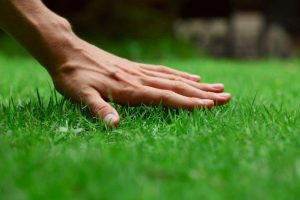⠀
Dealing With a Mossy Lawn
A lush green lawn is a source of pride for any homeowner, but when moss starts taking over, it can be a frustrating and unsightly problem. Removing moss from your lawn is essential to promote healthy grass growth and improve the overall appearance of your garden. One of the most effective ways to remove moss from your lawn is by using a powered scarifier and carrying out the process in the spring. Not only that but good mowing practises will help prevent moss from coming back. In this lawncare article, we will discuss the benefits of using a scarifier and how to manage a mossy lawn.
Understanding Moss
You may be wondering, what is moss? How does moss grow? Why is moss a problem for my lawn?
Moss can quickly take over a lawn, out competing the grass and creating unsightly areas of lawn. While moss may seem harmless, it can actually be a sign of an underlying problem with your lawn, such as poor drainage or compacted soil. Lawn compaction can be a contributing factor as compacted typically retains more moisture. Moss thrives in damp and shaded areas, and can quickly spread, suffocating your grass, and leaving your lawn looking patchy and unhealthy.
Understanding how moss grows is crucial to removing it effectively. Moss spreads through spores or small clippings that break off from the main plant. Unlike grass, which has a deep root system, moss attaches itself to the surface of the soil and absorbs water and nutrients through its leaves. This makes it relatively easy to remove with a scarifier but don’t underestimate the physical difficulty of this tiring lawncare job or the amount of moss that will need to be cleared up afterwards.
Preparing for scarifying
Scarification is an intensive process, especially if your lawn is particularly mossy or has not been scarified for a number of years. It’s important to mow the grass as short as possible before scarifying, so as to expose moss and reduce the grass leaf length to limit the possibility of the scarifier ripping out the grass plant along with the moss. Be sure to collect the clippings in our mower’s grass box or you will have more clearing up to do afterwards.
The best practise it to access how you wish to scarify your lawn and make a plan – for instance you may wish to do this against the direction that you would typically mow your lawn. In grass with heavy moss, a good lawncare practise would be to follow the process twice scarifying in two different directions for a better result.
Over-seeding your lawn after moss removal
Scarification is an intensive process. It removes thatch and moss from your lawn. Lawns with extensive moss can be left looking a little bare after the moss has been removed. We should work to support the recovery of the lawn after moss removal is completed. Over-seeding these bare patches can help to fill in the areas with new grass, making your lawn look fuller and healthier. Newer grass varieties are greener, deeper rooted, more drought and disease resistant. Introducing these new grass varieties to your lawn will greatly improve its appearance and vigour. The ideal time to over-seed is after scarification when seed can easily come into contact with bare soil which will help germination and young grass plant development.
Feeding your lawn
It’s a good idea to fertilise the lawn after scarifying as this can help to promote healthy grass re-growth and prevent moss from returning in the future. The type of fertiliser used is important too as you want to allow the new seed to germinate, and the young grass plants to establish, without too much competition from the original plants that are recovering. The correct balance of nitrogen, potassium and phosphorus is key to success.
Reducing lawn moss problems
After scarification, measures should be taken to kill any moss spores or remaining pieces of moss. Failing to do this can spread moss around the lawn and this will re-establish in the exposed soil before the grass recovers to compete with it. Ensuring bare areas are seeded and the lawn is correctly fed will encourage strong grass recovery to compete with moss. But it is essential not to skip the moss treatment after scarification – many people forget and we can help you with this
Moss and mowing
Incorrect mowing practices are a significant contributing factor to moss establishing in a lawn and out-competing the grass plants. The most common lawncare mistakes are infrequent mowing and mowing too short which will weaken grass. Also, mowing into existing moss will cut off part of the moss and spread it around the lawn allowing it to establish in new areas. If there is no grass leaf above the height of the moss, grass will not be able to compete for light.
Lawn moss prevention
Preventing moss from returning to your lawn requires a combination of good lawn maintenance practices and addressing the underlying conditions that allowed the moss to grow in the first place. Seasonal moss prevention lawncare treatments, along with proper fertilisation, and good soil management practices such as aeration and dethatching are essential. If you have a lawn that tends to get mossy then a light scarification each year will help with this. Getting the balance of treatments and mechanical work right is essential.
Speak to a lawncare professional in Hampshire for advice – we would be more than happy to assess your lawn – contact us today

 Established 2016
Established 2016






